Research Project: Employee Motivation in Vancouver Luxury Hotels
VerifiedAdded on 2020/06/04
|36
|9716
|46
Project
AI Summary
This project investigates employee motivation within the luxury hotel sector in the Vancouver area, focusing on identifying key motivational factors, assessing their impact on employee performance, and evaluating the relationship between employee motivation and customer satisfaction. The research delves into the role of Human Resources (HR) management in fostering employee motivation and explores the significance of rewards and recognition. The study examines employee satisfaction, performance, and the influence of intrinsic and extrinsic motivators, using research questions to guide the investigation. Data collection methods, including population, sampling, and data analysis techniques, are outlined to provide a comprehensive understanding of the dynamics between employee motivation, customer satisfaction, and the overall success of luxury hotels. The project aims to provide insights into the most effective strategies for motivating employees and enhancing service quality within the hospitality industry.
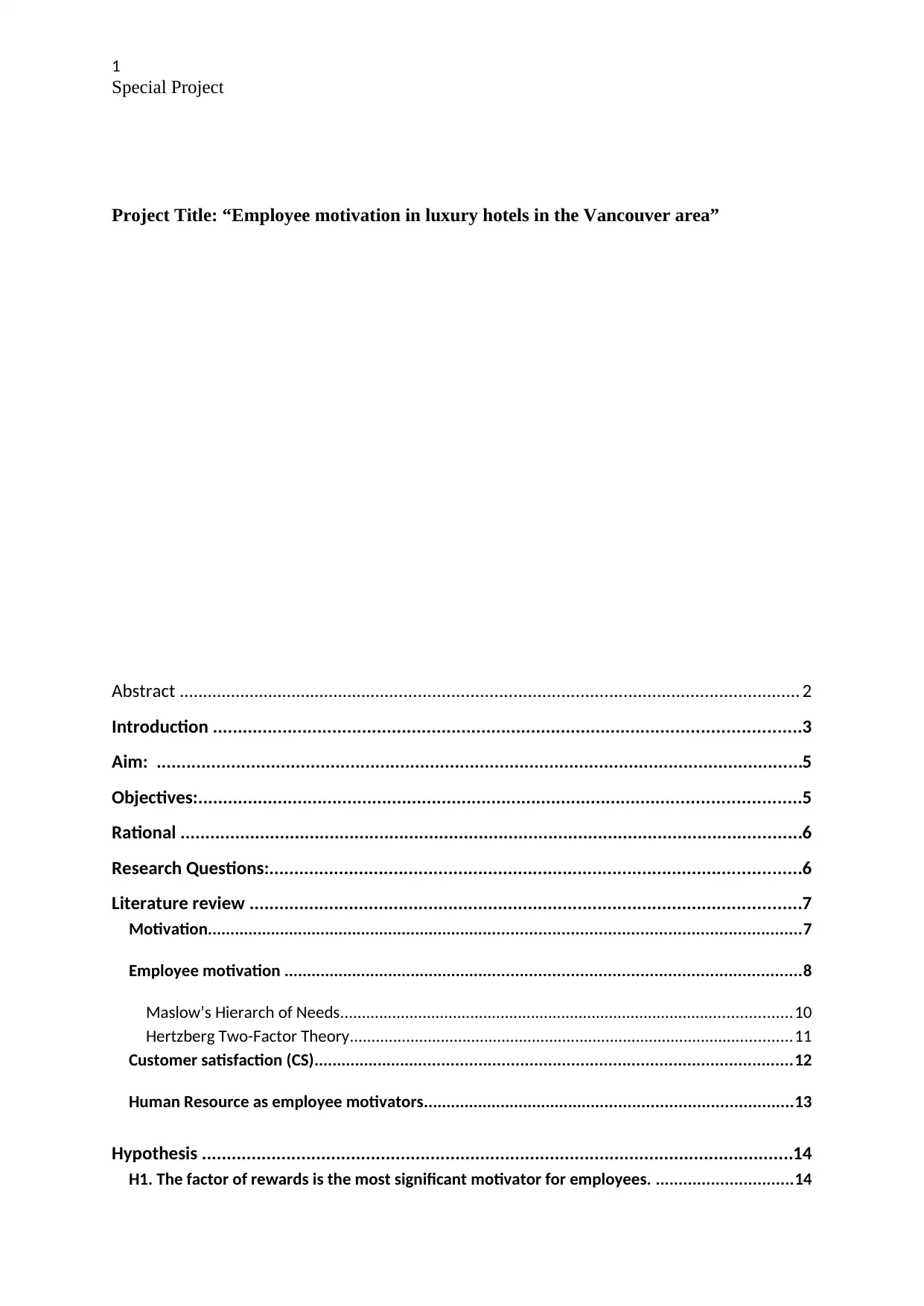
1
Special Project
Project Title: “Employee motivation in luxury hotels in the Vancouver area”
Abstract ................................................................................................................................... 2
Introduction ......................................................................................................................3
Aim: ..................................................................................................................................5
Objectives:.........................................................................................................................5
Rational .............................................................................................................................6
Research Questions:...........................................................................................................6
Literature review ...............................................................................................................7
Motivation..................................................................................................................................7
Employee motivation .................................................................................................................8
Maslow’s Hierarch of Needs........................................................................................................10
Hertzberg Two-Factor Theory......................................................................................................11
Customer satisfaction (CS)........................................................................................................12
Human Resource as employee motivators.................................................................................13
Hypothesis .......................................................................................................................14
H1. The factor of rewards is the most significant motivator for employees. ..............................14
Special Project
Project Title: “Employee motivation in luxury hotels in the Vancouver area”
Abstract ................................................................................................................................... 2
Introduction ......................................................................................................................3
Aim: ..................................................................................................................................5
Objectives:.........................................................................................................................5
Rational .............................................................................................................................6
Research Questions:...........................................................................................................6
Literature review ...............................................................................................................7
Motivation..................................................................................................................................7
Employee motivation .................................................................................................................8
Maslow’s Hierarch of Needs........................................................................................................10
Hertzberg Two-Factor Theory......................................................................................................11
Customer satisfaction (CS)........................................................................................................12
Human Resource as employee motivators.................................................................................13
Hypothesis .......................................................................................................................14
H1. The factor of rewards is the most significant motivator for employees. ..............................14
Paraphrase This Document
Need a fresh take? Get an instant paraphrase of this document with our AI Paraphraser
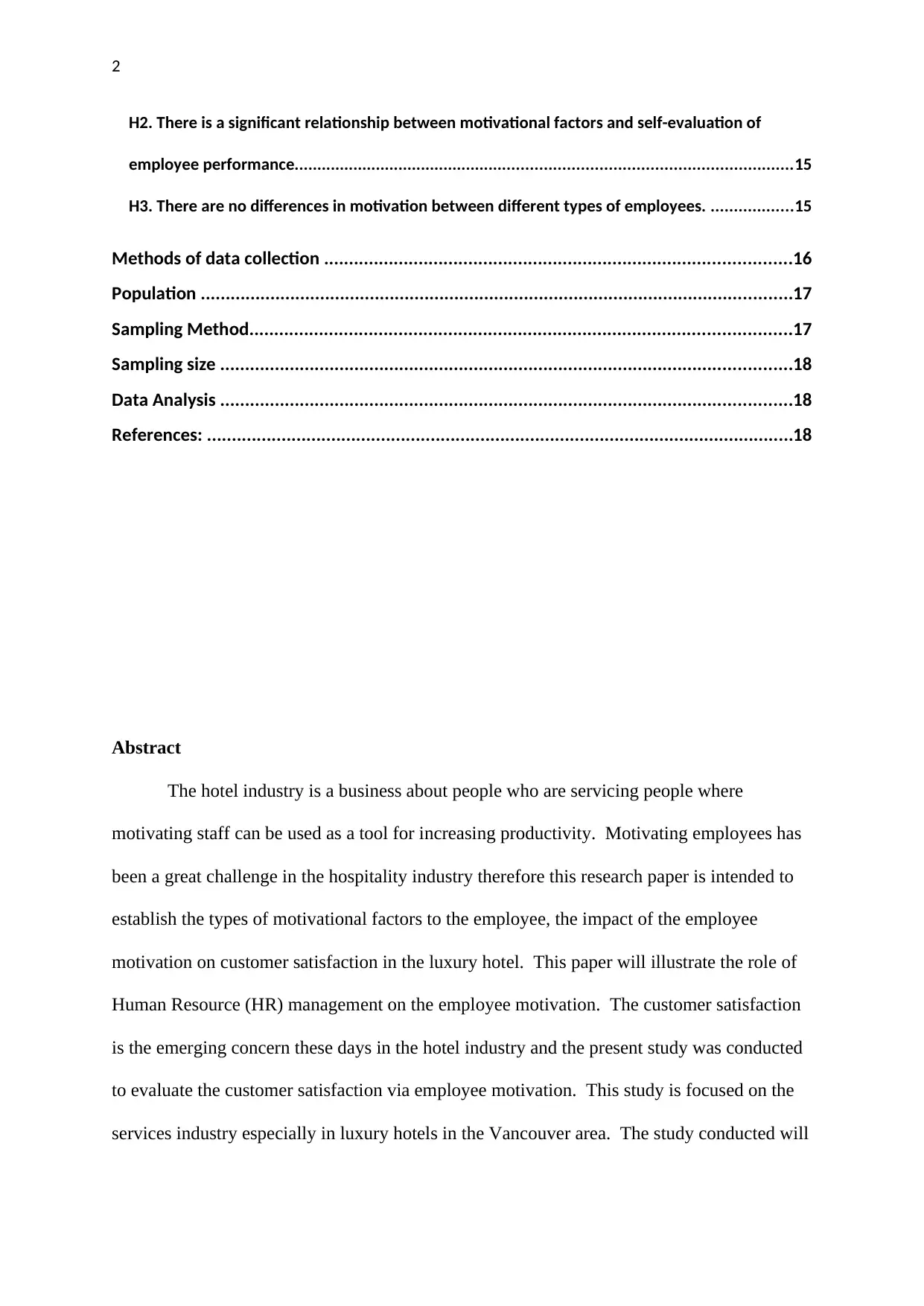
2
H2. There is a significant relationship between motivational factors and self-evaluation of
employee performance.............................................................................................................15
H3. There are no differences in motivation between different types of employees. ..................15
Methods of data collection ..............................................................................................16
Population .......................................................................................................................17
Sampling Method.............................................................................................................17
Sampling size ...................................................................................................................18
Data Analysis ...................................................................................................................18
References: ......................................................................................................................18
Abstract
The hotel industry is a business about people who are servicing people where
motivating staff can be used as a tool for increasing productivity. Motivating employees has
been a great challenge in the hospitality industry therefore this research paper is intended to
establish the types of motivational factors to the employee, the impact of the employee
motivation on customer satisfaction in the luxury hotel. This paper will illustrate the role of
Human Resource (HR) management on the employee motivation. The customer satisfaction
is the emerging concern these days in the hotel industry and the present study was conducted
to evaluate the customer satisfaction via employee motivation. This study is focused on the
services industry especially in luxury hotels in the Vancouver area. The study conducted will
H2. There is a significant relationship between motivational factors and self-evaluation of
employee performance.............................................................................................................15
H3. There are no differences in motivation between different types of employees. ..................15
Methods of data collection ..............................................................................................16
Population .......................................................................................................................17
Sampling Method.............................................................................................................17
Sampling size ...................................................................................................................18
Data Analysis ...................................................................................................................18
References: ......................................................................................................................18
Abstract
The hotel industry is a business about people who are servicing people where
motivating staff can be used as a tool for increasing productivity. Motivating employees has
been a great challenge in the hospitality industry therefore this research paper is intended to
establish the types of motivational factors to the employee, the impact of the employee
motivation on customer satisfaction in the luxury hotel. This paper will illustrate the role of
Human Resource (HR) management on the employee motivation. The customer satisfaction
is the emerging concern these days in the hotel industry and the present study was conducted
to evaluate the customer satisfaction via employee motivation. This study is focused on the
services industry especially in luxury hotels in the Vancouver area. The study conducted will
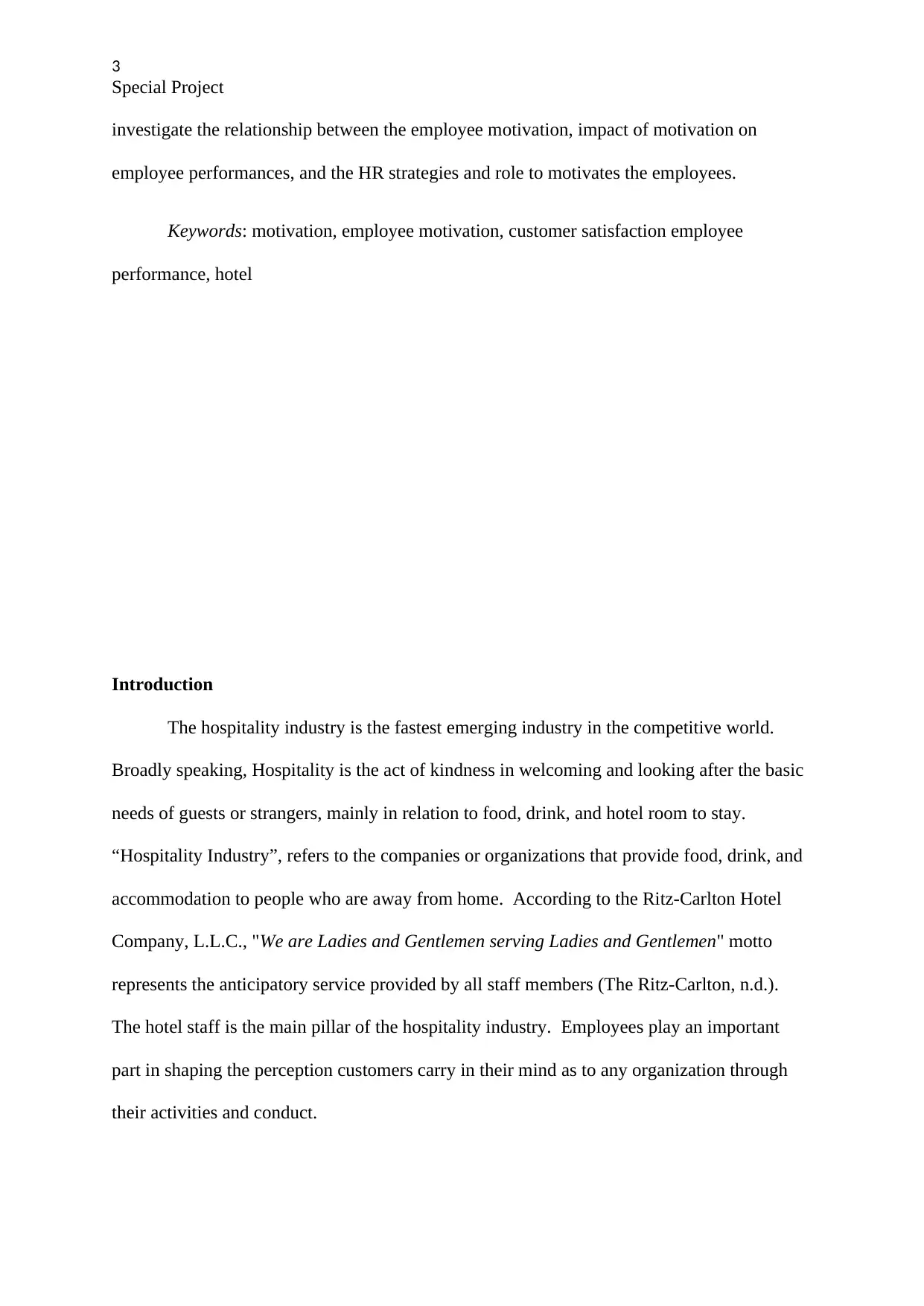
3
Special Project
investigate the relationship between the employee motivation, impact of motivation on
employee performances, and the HR strategies and role to motivates the employees.
Keywords: motivation, employee motivation, customer satisfaction employee
performance, hotel
Introduction
The hospitality industry is the fastest emerging industry in the competitive world.
Broadly speaking, Hospitality is the act of kindness in welcoming and looking after the basic
needs of guests or strangers, mainly in relation to food, drink, and hotel room to stay.
“Hospitality Industry”, refers to the companies or organizations that provide food, drink, and
accommodation to people who are away from home. According to the Ritz-Carlton Hotel
Company, L.L.C., "We are Ladies and Gentlemen serving Ladies and Gentlemen" motto
represents the anticipatory service provided by all staff members (The Ritz-Carlton, n.d.).
The hotel staff is the main pillar of the hospitality industry. Employees play an important
part in shaping the perception customers carry in their mind as to any organization through
their activities and conduct.
Special Project
investigate the relationship between the employee motivation, impact of motivation on
employee performances, and the HR strategies and role to motivates the employees.
Keywords: motivation, employee motivation, customer satisfaction employee
performance, hotel
Introduction
The hospitality industry is the fastest emerging industry in the competitive world.
Broadly speaking, Hospitality is the act of kindness in welcoming and looking after the basic
needs of guests or strangers, mainly in relation to food, drink, and hotel room to stay.
“Hospitality Industry”, refers to the companies or organizations that provide food, drink, and
accommodation to people who are away from home. According to the Ritz-Carlton Hotel
Company, L.L.C., "We are Ladies and Gentlemen serving Ladies and Gentlemen" motto
represents the anticipatory service provided by all staff members (The Ritz-Carlton, n.d.).
The hotel staff is the main pillar of the hospitality industry. Employees play an important
part in shaping the perception customers carry in their mind as to any organization through
their activities and conduct.
⊘ This is a preview!⊘
Do you want full access?
Subscribe today to unlock all pages.

Trusted by 1+ million students worldwide
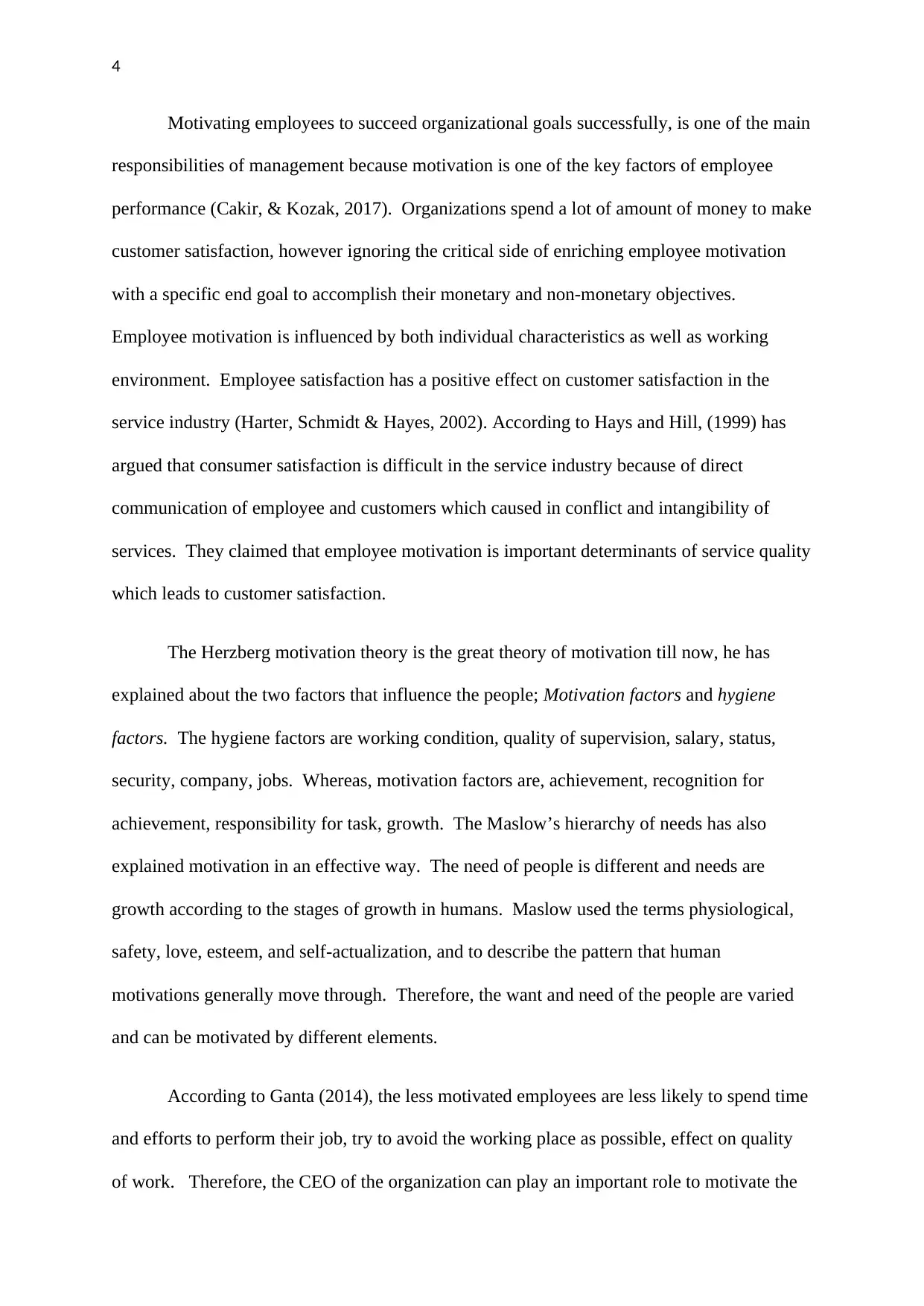
4
Motivating employees to succeed organizational goals successfully, is one of the main
responsibilities of management because motivation is one of the key factors of employee
performance (Cakir, & Kozak, 2017). Organizations spend a lot of amount of money to make
customer satisfaction, however ignoring the critical side of enriching employee motivation
with a specific end goal to accomplish their monetary and non-monetary objectives.
Employee motivation is influenced by both individual characteristics as well as working
environment. Employee satisfaction has a positive effect on customer satisfaction in the
service industry (Harter, Schmidt & Hayes, 2002). According to Hays and Hill, (1999) has
argued that consumer satisfaction is difficult in the service industry because of direct
communication of employee and customers which caused in conflict and intangibility of
services. They claimed that employee motivation is important determinants of service quality
which leads to customer satisfaction.
The Herzberg motivation theory is the great theory of motivation till now, he has
explained about the two factors that influence the people; Motivation factors and hygiene
factors. The hygiene factors are working condition, quality of supervision, salary, status,
security, company, jobs. Whereas, motivation factors are, achievement, recognition for
achievement, responsibility for task, growth. The Maslow’s hierarchy of needs has also
explained motivation in an effective way. The need of people is different and needs are
growth according to the stages of growth in humans. Maslow used the terms physiological,
safety, love, esteem, and self-actualization, and to describe the pattern that human
motivations generally move through. Therefore, the want and need of the people are varied
and can be motivated by different elements.
According to Ganta (2014), the less motivated employees are less likely to spend time
and efforts to perform their job, try to avoid the working place as possible, effect on quality
of work. Therefore, the CEO of the organization can play an important role to motivate the
Motivating employees to succeed organizational goals successfully, is one of the main
responsibilities of management because motivation is one of the key factors of employee
performance (Cakir, & Kozak, 2017). Organizations spend a lot of amount of money to make
customer satisfaction, however ignoring the critical side of enriching employee motivation
with a specific end goal to accomplish their monetary and non-monetary objectives.
Employee motivation is influenced by both individual characteristics as well as working
environment. Employee satisfaction has a positive effect on customer satisfaction in the
service industry (Harter, Schmidt & Hayes, 2002). According to Hays and Hill, (1999) has
argued that consumer satisfaction is difficult in the service industry because of direct
communication of employee and customers which caused in conflict and intangibility of
services. They claimed that employee motivation is important determinants of service quality
which leads to customer satisfaction.
The Herzberg motivation theory is the great theory of motivation till now, he has
explained about the two factors that influence the people; Motivation factors and hygiene
factors. The hygiene factors are working condition, quality of supervision, salary, status,
security, company, jobs. Whereas, motivation factors are, achievement, recognition for
achievement, responsibility for task, growth. The Maslow’s hierarchy of needs has also
explained motivation in an effective way. The need of people is different and needs are
growth according to the stages of growth in humans. Maslow used the terms physiological,
safety, love, esteem, and self-actualization, and to describe the pattern that human
motivations generally move through. Therefore, the want and need of the people are varied
and can be motivated by different elements.
According to Ganta (2014), the less motivated employees are less likely to spend time
and efforts to perform their job, try to avoid the working place as possible, effect on quality
of work. Therefore, the CEO of the organization can play an important role to motivate the
Paraphrase This Document
Need a fresh take? Get an instant paraphrase of this document with our AI Paraphraser
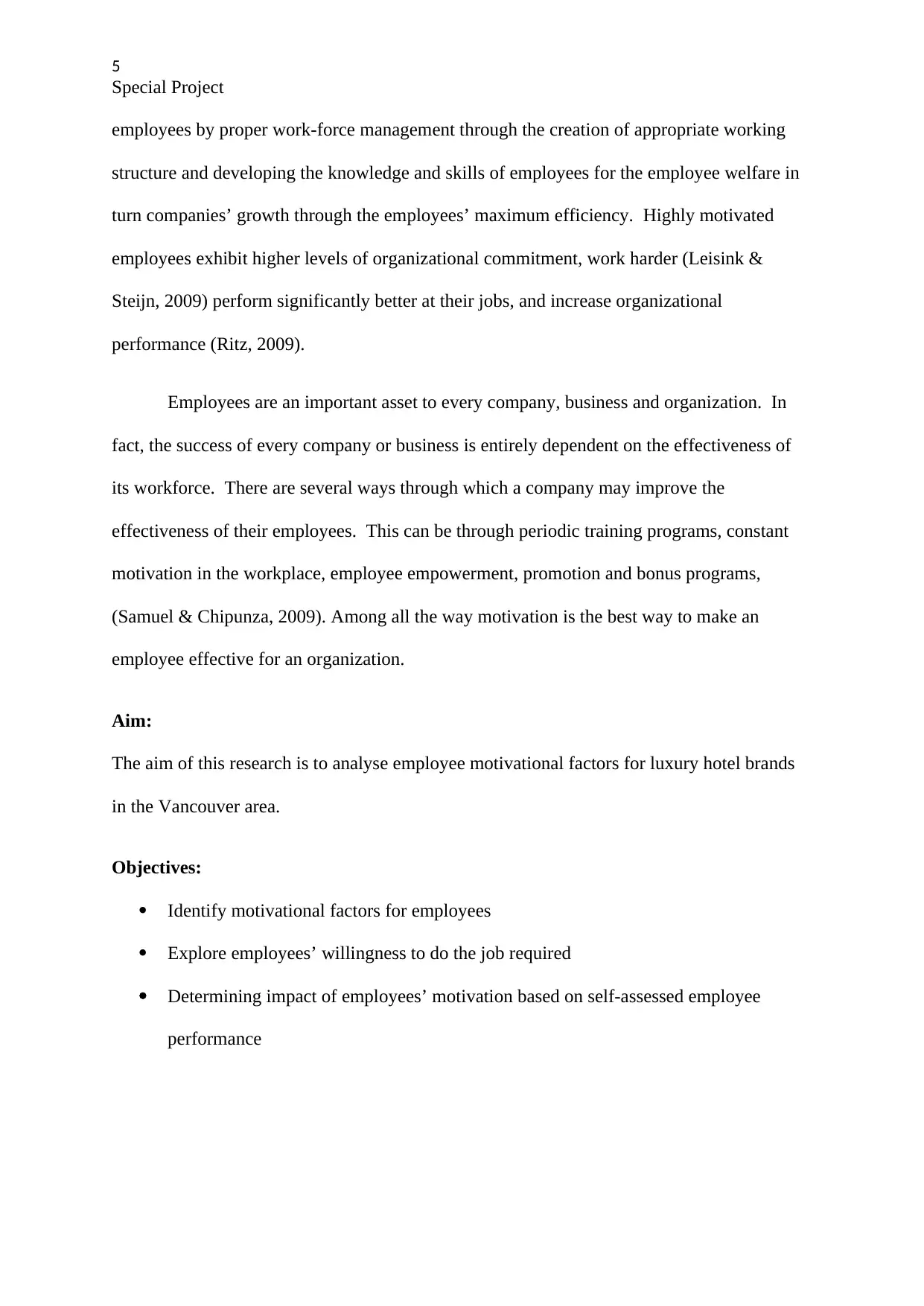
5
Special Project
employees by proper work-force management through the creation of appropriate working
structure and developing the knowledge and skills of employees for the employee welfare in
turn companies’ growth through the employees’ maximum efficiency. Highly motivated
employees exhibit higher levels of organizational commitment, work harder (Leisink &
Steijn, 2009) perform significantly better at their jobs, and increase organizational
performance (Ritz, 2009).
Employees are an important asset to every company, business and organization. In
fact, the success of every company or business is entirely dependent on the effectiveness of
its workforce. There are several ways through which a company may improve the
effectiveness of their employees. This can be through periodic training programs, constant
motivation in the workplace, employee empowerment, promotion and bonus programs,
(Samuel & Chipunza, 2009). Among all the way motivation is the best way to make an
employee effective for an organization.
Aim:
The aim of this research is to analyse employee motivational factors for luxury hotel brands
in the Vancouver area.
Objectives:
Identify motivational factors for employees
Explore employees’ willingness to do the job required
Determining impact of employees’ motivation based on self-assessed employee
performance
Special Project
employees by proper work-force management through the creation of appropriate working
structure and developing the knowledge and skills of employees for the employee welfare in
turn companies’ growth through the employees’ maximum efficiency. Highly motivated
employees exhibit higher levels of organizational commitment, work harder (Leisink &
Steijn, 2009) perform significantly better at their jobs, and increase organizational
performance (Ritz, 2009).
Employees are an important asset to every company, business and organization. In
fact, the success of every company or business is entirely dependent on the effectiveness of
its workforce. There are several ways through which a company may improve the
effectiveness of their employees. This can be through periodic training programs, constant
motivation in the workplace, employee empowerment, promotion and bonus programs,
(Samuel & Chipunza, 2009). Among all the way motivation is the best way to make an
employee effective for an organization.
Aim:
The aim of this research is to analyse employee motivational factors for luxury hotel brands
in the Vancouver area.
Objectives:
Identify motivational factors for employees
Explore employees’ willingness to do the job required
Determining impact of employees’ motivation based on self-assessed employee
performance
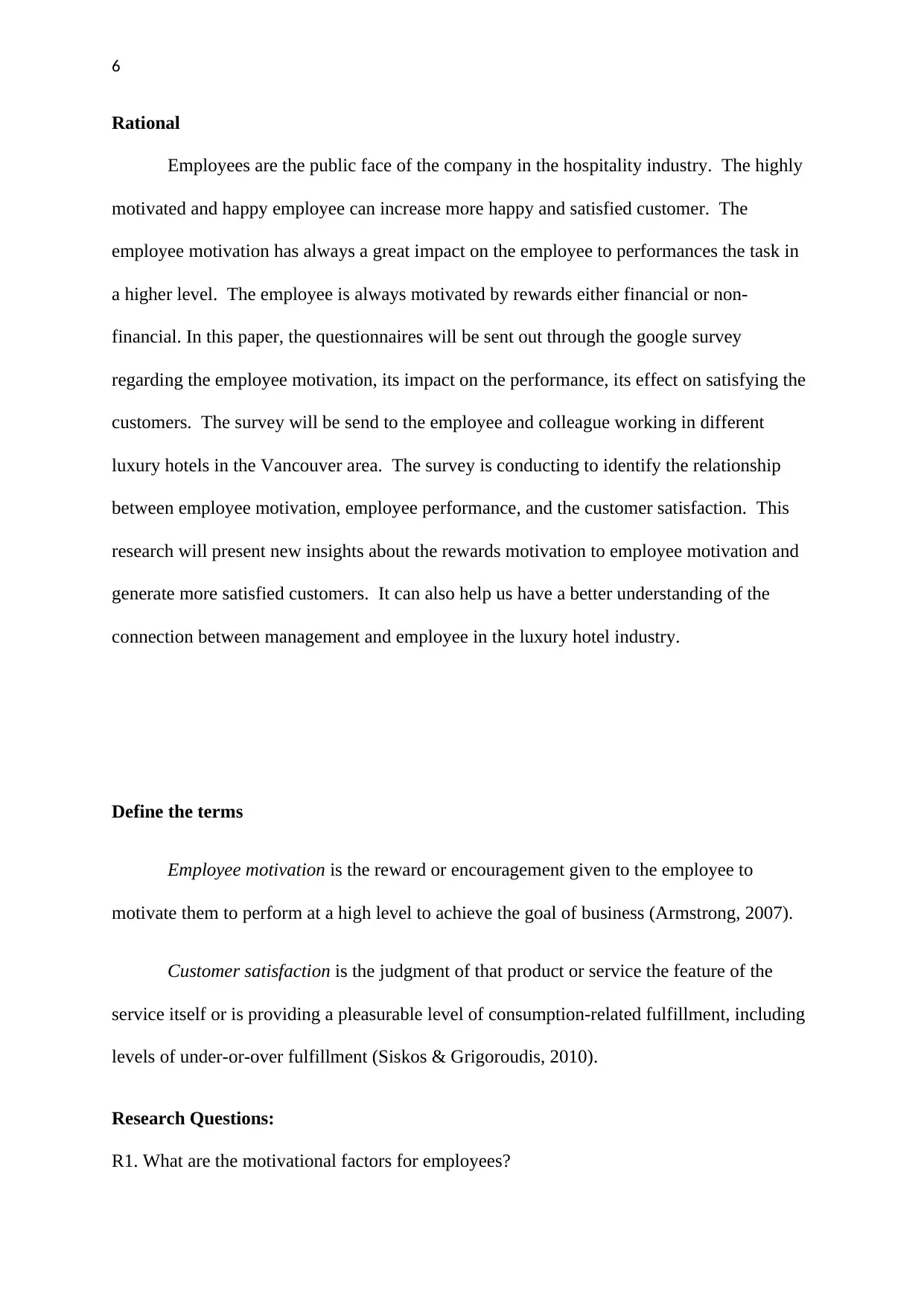
6
Rational
Employees are the public face of the company in the hospitality industry. The highly
motivated and happy employee can increase more happy and satisfied customer. The
employee motivation has always a great impact on the employee to performances the task in
a higher level. The employee is always motivated by rewards either financial or non-
financial. In this paper, the questionnaires will be sent out through the google survey
regarding the employee motivation, its impact on the performance, its effect on satisfying the
customers. The survey will be send to the employee and colleague working in different
luxury hotels in the Vancouver area. The survey is conducting to identify the relationship
between employee motivation, employee performance, and the customer satisfaction. This
research will present new insights about the rewards motivation to employee motivation and
generate more satisfied customers. It can also help us have a better understanding of the
connection between management and employee in the luxury hotel industry.
Define the terms
Employee motivation is the reward or encouragement given to the employee to
motivate them to perform at a high level to achieve the goal of business (Armstrong, 2007).
Customer satisfaction is the judgment of that product or service the feature of the
service itself or is providing a pleasurable level of consumption-related fulfillment, including
levels of under-or-over fulfillment (Siskos & Grigoroudis, 2010).
Research Questions:
R1. What are the motivational factors for employees?
Rational
Employees are the public face of the company in the hospitality industry. The highly
motivated and happy employee can increase more happy and satisfied customer. The
employee motivation has always a great impact on the employee to performances the task in
a higher level. The employee is always motivated by rewards either financial or non-
financial. In this paper, the questionnaires will be sent out through the google survey
regarding the employee motivation, its impact on the performance, its effect on satisfying the
customers. The survey will be send to the employee and colleague working in different
luxury hotels in the Vancouver area. The survey is conducting to identify the relationship
between employee motivation, employee performance, and the customer satisfaction. This
research will present new insights about the rewards motivation to employee motivation and
generate more satisfied customers. It can also help us have a better understanding of the
connection between management and employee in the luxury hotel industry.
Define the terms
Employee motivation is the reward or encouragement given to the employee to
motivate them to perform at a high level to achieve the goal of business (Armstrong, 2007).
Customer satisfaction is the judgment of that product or service the feature of the
service itself or is providing a pleasurable level of consumption-related fulfillment, including
levels of under-or-over fulfillment (Siskos & Grigoroudis, 2010).
Research Questions:
R1. What are the motivational factors for employees?
⊘ This is a preview!⊘
Do you want full access?
Subscribe today to unlock all pages.

Trusted by 1+ million students worldwide
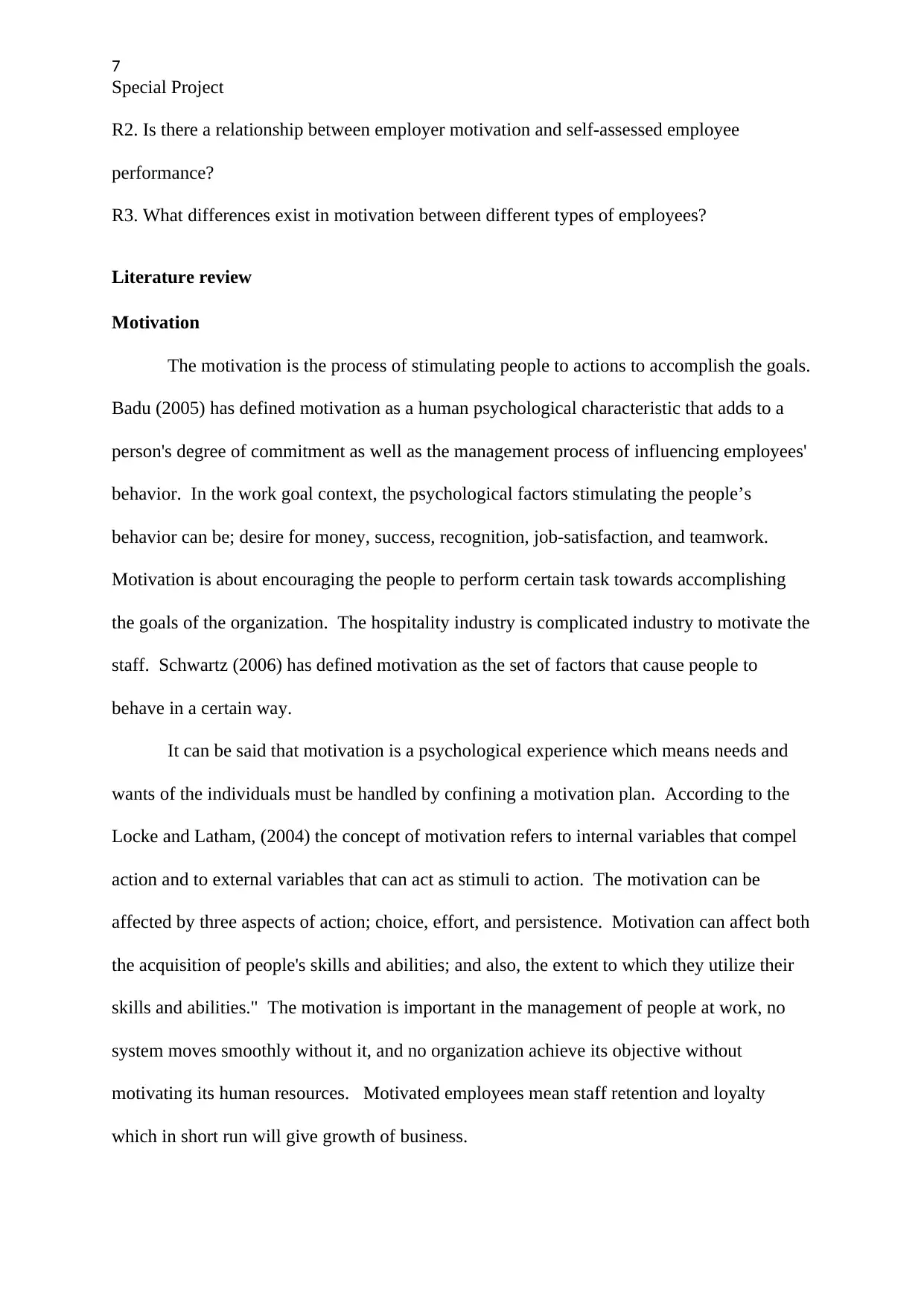
7
Special Project
R2. Is there a relationship between employer motivation and self-assessed employee
performance?
R3. What differences exist in motivation between different types of employees?
Literature review
Motivation
The motivation is the process of stimulating people to actions to accomplish the goals.
Badu (2005) has defined motivation as a human psychological characteristic that adds to a
person's degree of commitment as well as the management process of influencing employees'
behavior. In the work goal context, the psychological factors stimulating the people’s
behavior can be; desire for money, success, recognition, job-satisfaction, and teamwork.
Motivation is about encouraging the people to perform certain task towards accomplishing
the goals of the organization. The hospitality industry is complicated industry to motivate the
staff. Schwartz (2006) has defined motivation as the set of factors that cause people to
behave in a certain way.
It can be said that motivation is a psychological experience which means needs and
wants of the individuals must be handled by confining a motivation plan. According to the
Locke and Latham, (2004) the concept of motivation refers to internal variables that compel
action and to external variables that can act as stimuli to action. The motivation can be
affected by three aspects of action; choice, effort, and persistence. Motivation can affect both
the acquisition of people's skills and abilities; and also, the extent to which they utilize their
skills and abilities." The motivation is important in the management of people at work, no
system moves smoothly without it, and no organization achieve its objective without
motivating its human resources. Motivated employees mean staff retention and loyalty
which in short run will give growth of business.
Special Project
R2. Is there a relationship between employer motivation and self-assessed employee
performance?
R3. What differences exist in motivation between different types of employees?
Literature review
Motivation
The motivation is the process of stimulating people to actions to accomplish the goals.
Badu (2005) has defined motivation as a human psychological characteristic that adds to a
person's degree of commitment as well as the management process of influencing employees'
behavior. In the work goal context, the psychological factors stimulating the people’s
behavior can be; desire for money, success, recognition, job-satisfaction, and teamwork.
Motivation is about encouraging the people to perform certain task towards accomplishing
the goals of the organization. The hospitality industry is complicated industry to motivate the
staff. Schwartz (2006) has defined motivation as the set of factors that cause people to
behave in a certain way.
It can be said that motivation is a psychological experience which means needs and
wants of the individuals must be handled by confining a motivation plan. According to the
Locke and Latham, (2004) the concept of motivation refers to internal variables that compel
action and to external variables that can act as stimuli to action. The motivation can be
affected by three aspects of action; choice, effort, and persistence. Motivation can affect both
the acquisition of people's skills and abilities; and also, the extent to which they utilize their
skills and abilities." The motivation is important in the management of people at work, no
system moves smoothly without it, and no organization achieve its objective without
motivating its human resources. Motivated employees mean staff retention and loyalty
which in short run will give growth of business.
Paraphrase This Document
Need a fresh take? Get an instant paraphrase of this document with our AI Paraphraser
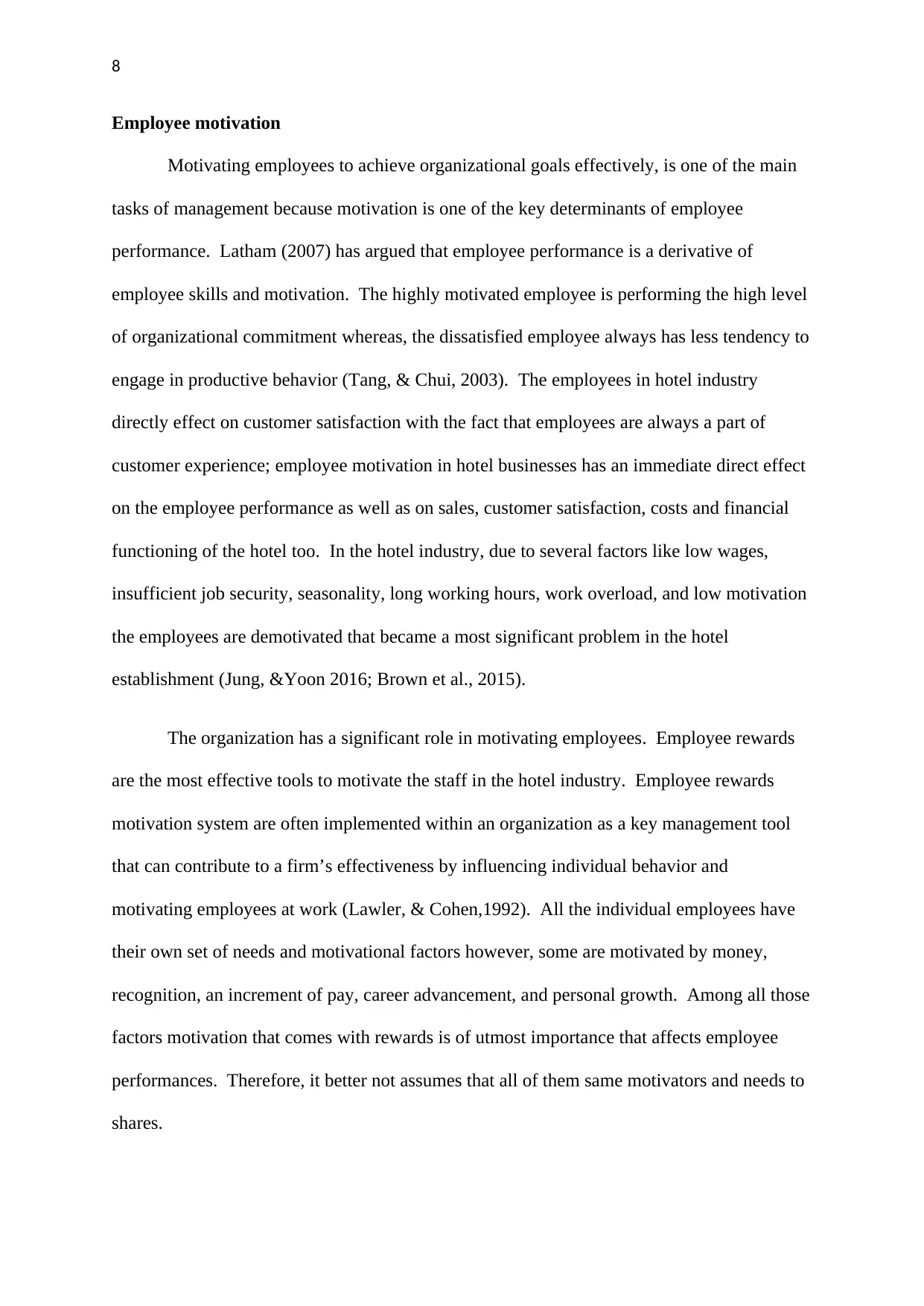
8
Employee motivation
Motivating employees to achieve organizational goals effectively, is one of the main
tasks of management because motivation is one of the key determinants of employee
performance. Latham (2007) has argued that employee performance is a derivative of
employee skills and motivation. The highly motivated employee is performing the high level
of organizational commitment whereas, the dissatisfied employee always has less tendency to
engage in productive behavior (Tang, & Chui, 2003). The employees in hotel industry
directly effect on customer satisfaction with the fact that employees are always a part of
customer experience; employee motivation in hotel businesses has an immediate direct effect
on the employee performance as well as on sales, customer satisfaction, costs and financial
functioning of the hotel too. In the hotel industry, due to several factors like low wages,
insufficient job security, seasonality, long working hours, work overload, and low motivation
the employees are demotivated that became a most significant problem in the hotel
establishment (Jung, &Yoon 2016; Brown et al., 2015).
The organization has a significant role in motivating employees. Employee rewards
are the most effective tools to motivate the staff in the hotel industry. Employee rewards
motivation system are often implemented within an organization as a key management tool
that can contribute to a firm’s effectiveness by influencing individual behavior and
motivating employees at work (Lawler, & Cohen,1992). All the individual employees have
their own set of needs and motivational factors however, some are motivated by money,
recognition, an increment of pay, career advancement, and personal growth. Among all those
factors motivation that comes with rewards is of utmost importance that affects employee
performances. Therefore, it better not assumes that all of them same motivators and needs to
shares.
Employee motivation
Motivating employees to achieve organizational goals effectively, is one of the main
tasks of management because motivation is one of the key determinants of employee
performance. Latham (2007) has argued that employee performance is a derivative of
employee skills and motivation. The highly motivated employee is performing the high level
of organizational commitment whereas, the dissatisfied employee always has less tendency to
engage in productive behavior (Tang, & Chui, 2003). The employees in hotel industry
directly effect on customer satisfaction with the fact that employees are always a part of
customer experience; employee motivation in hotel businesses has an immediate direct effect
on the employee performance as well as on sales, customer satisfaction, costs and financial
functioning of the hotel too. In the hotel industry, due to several factors like low wages,
insufficient job security, seasonality, long working hours, work overload, and low motivation
the employees are demotivated that became a most significant problem in the hotel
establishment (Jung, &Yoon 2016; Brown et al., 2015).
The organization has a significant role in motivating employees. Employee rewards
are the most effective tools to motivate the staff in the hotel industry. Employee rewards
motivation system are often implemented within an organization as a key management tool
that can contribute to a firm’s effectiveness by influencing individual behavior and
motivating employees at work (Lawler, & Cohen,1992). All the individual employees have
their own set of needs and motivational factors however, some are motivated by money,
recognition, an increment of pay, career advancement, and personal growth. Among all those
factors motivation that comes with rewards is of utmost importance that affects employee
performances. Therefore, it better not assumes that all of them same motivators and needs to
shares.
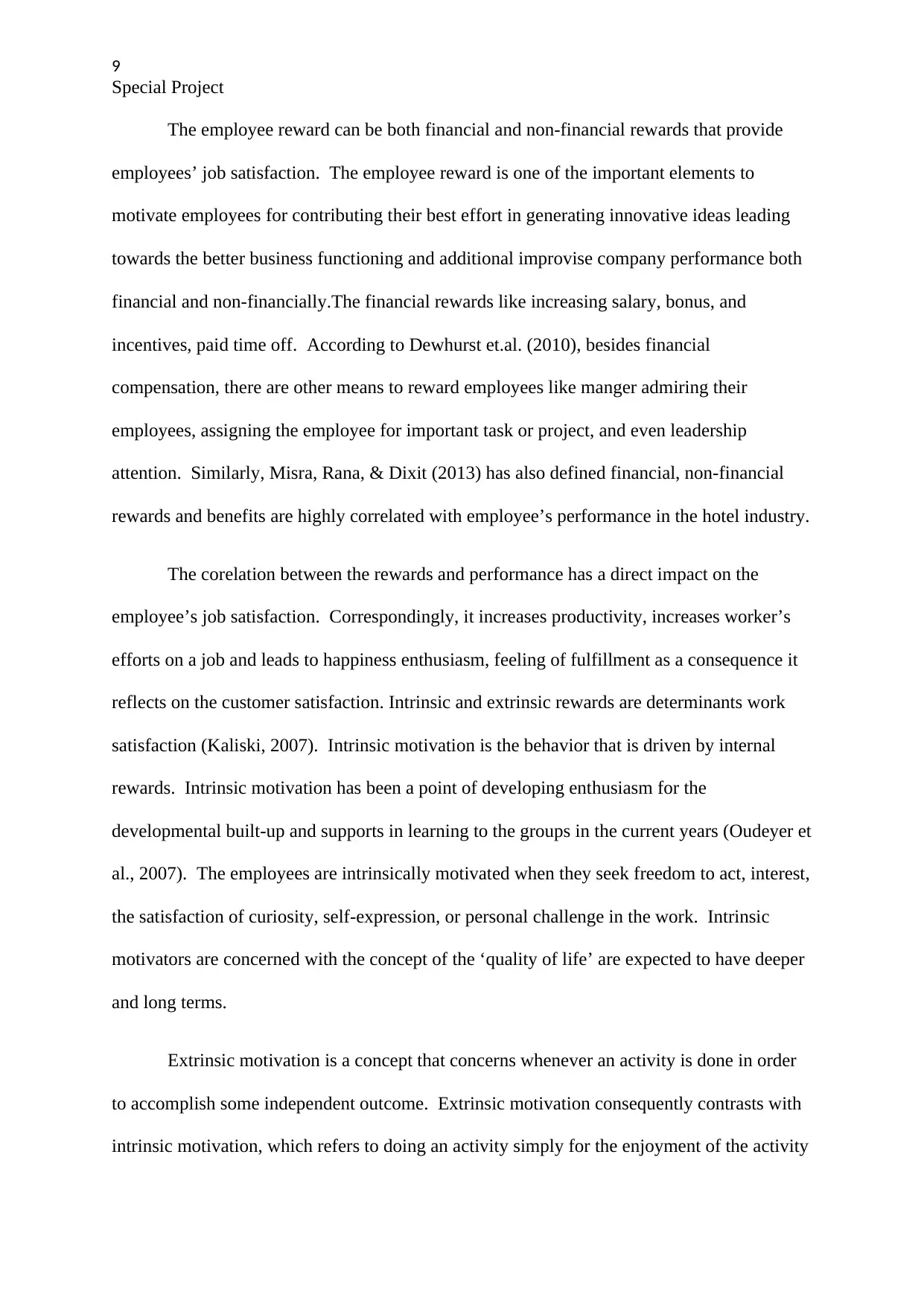
9
Special Project
The employee reward can be both financial and non-financial rewards that provide
employees’ job satisfaction. The employee reward is one of the important elements to
motivate employees for contributing their best effort in generating innovative ideas leading
towards the better business functioning and additional improvise company performance both
financial and non-financially.The financial rewards like increasing salary, bonus, and
incentives, paid time off. According to Dewhurst et.al. (2010), besides financial
compensation, there are other means to reward employees like manger admiring their
employees, assigning the employee for important task or project, and even leadership
attention. Similarly, Misra, Rana, & Dixit (2013) has also defined financial, non-financial
rewards and benefits are highly correlated with employee’s performance in the hotel industry.
The corelation between the rewards and performance has a direct impact on the
employee’s job satisfaction. Correspondingly, it increases productivity, increases worker’s
efforts on a job and leads to happiness enthusiasm, feeling of fulfillment as a consequence it
reflects on the customer satisfaction. Intrinsic and extrinsic rewards are determinants work
satisfaction (Kaliski, 2007). Intrinsic motivation is the behavior that is driven by internal
rewards. Intrinsic motivation has been a point of developing enthusiasm for the
developmental built-up and supports in learning to the groups in the current years (Oudeyer et
al., 2007). The employees are intrinsically motivated when they seek freedom to act, interest,
the satisfaction of curiosity, self-expression, or personal challenge in the work. Intrinsic
motivators are concerned with the concept of the ‘quality of life’ are expected to have deeper
and long terms.
Extrinsic motivation is a concept that concerns whenever an activity is done in order
to accomplish some independent outcome. Extrinsic motivation consequently contrasts with
intrinsic motivation, which refers to doing an activity simply for the enjoyment of the activity
Special Project
The employee reward can be both financial and non-financial rewards that provide
employees’ job satisfaction. The employee reward is one of the important elements to
motivate employees for contributing their best effort in generating innovative ideas leading
towards the better business functioning and additional improvise company performance both
financial and non-financially.The financial rewards like increasing salary, bonus, and
incentives, paid time off. According to Dewhurst et.al. (2010), besides financial
compensation, there are other means to reward employees like manger admiring their
employees, assigning the employee for important task or project, and even leadership
attention. Similarly, Misra, Rana, & Dixit (2013) has also defined financial, non-financial
rewards and benefits are highly correlated with employee’s performance in the hotel industry.
The corelation between the rewards and performance has a direct impact on the
employee’s job satisfaction. Correspondingly, it increases productivity, increases worker’s
efforts on a job and leads to happiness enthusiasm, feeling of fulfillment as a consequence it
reflects on the customer satisfaction. Intrinsic and extrinsic rewards are determinants work
satisfaction (Kaliski, 2007). Intrinsic motivation is the behavior that is driven by internal
rewards. Intrinsic motivation has been a point of developing enthusiasm for the
developmental built-up and supports in learning to the groups in the current years (Oudeyer et
al., 2007). The employees are intrinsically motivated when they seek freedom to act, interest,
the satisfaction of curiosity, self-expression, or personal challenge in the work. Intrinsic
motivators are concerned with the concept of the ‘quality of life’ are expected to have deeper
and long terms.
Extrinsic motivation is a concept that concerns whenever an activity is done in order
to accomplish some independent outcome. Extrinsic motivation consequently contrasts with
intrinsic motivation, which refers to doing an activity simply for the enjoyment of the activity
⊘ This is a preview!⊘
Do you want full access?
Subscribe today to unlock all pages.

Trusted by 1+ million students worldwide
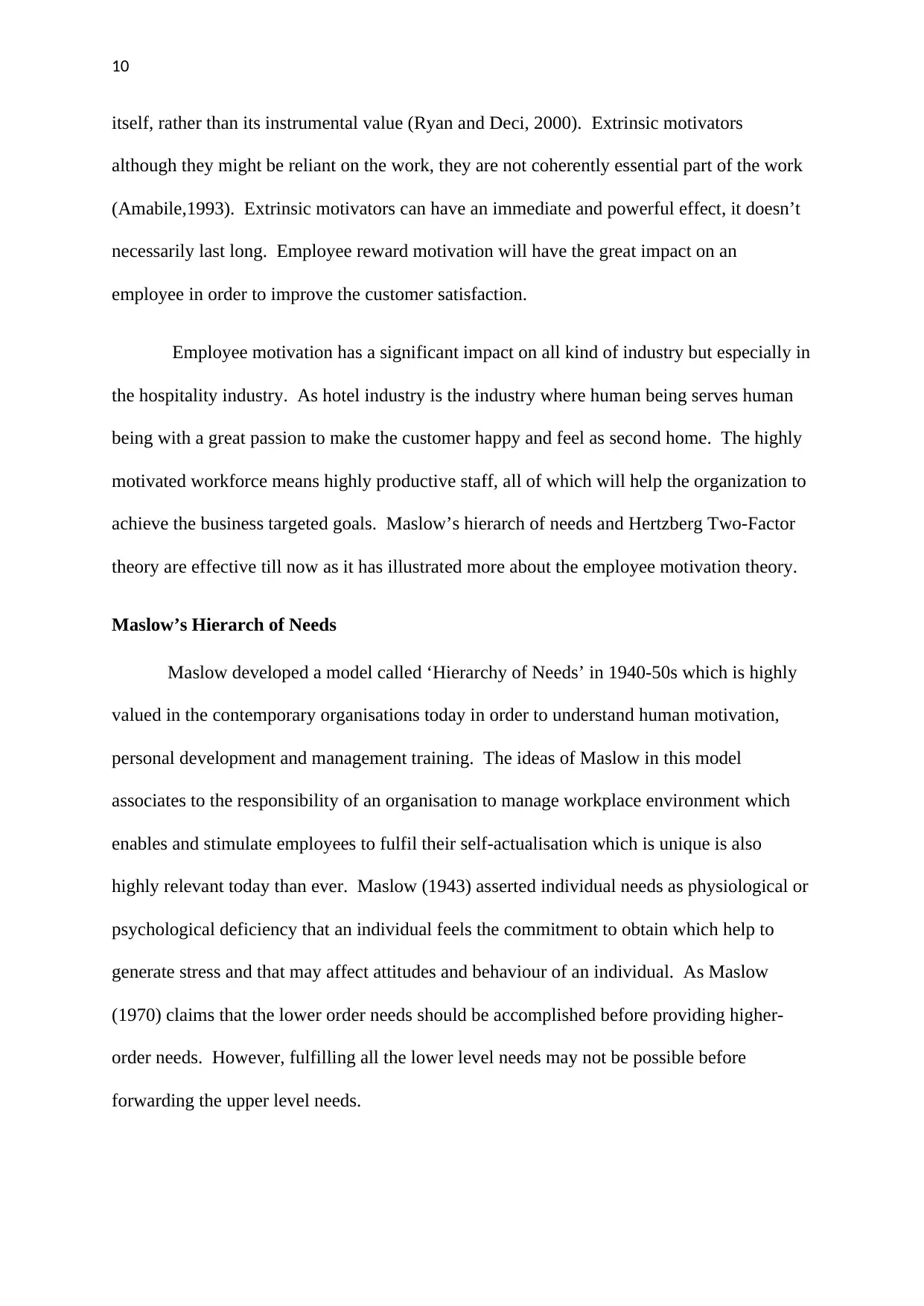
10
itself, rather than its instrumental value (Ryan and Deci, 2000). Extrinsic motivators
although they might be reliant on the work, they are not coherently essential part of the work
(Amabile,1993). Extrinsic motivators can have an immediate and powerful effect, it doesn’t
necessarily last long. Employee reward motivation will have the great impact on an
employee in order to improve the customer satisfaction.
Employee motivation has a significant impact on all kind of industry but especially in
the hospitality industry. As hotel industry is the industry where human being serves human
being with a great passion to make the customer happy and feel as second home. The highly
motivated workforce means highly productive staff, all of which will help the organization to
achieve the business targeted goals. Maslow’s hierarch of needs and Hertzberg Two-Factor
theory are effective till now as it has illustrated more about the employee motivation theory.
Maslow’s Hierarch of Needs
Maslow developed a model called ‘Hierarchy of Needs’ in 1940-50s which is highly
valued in the contemporary organisations today in order to understand human motivation,
personal development and management training. The ideas of Maslow in this model
associates to the responsibility of an organisation to manage workplace environment which
enables and stimulate employees to fulfil their self-actualisation which is unique is also
highly relevant today than ever. Maslow (1943) asserted individual needs as physiological or
psychological deficiency that an individual feels the commitment to obtain which help to
generate stress and that may affect attitudes and behaviour of an individual. As Maslow
(1970) claims that the lower order needs should be accomplished before providing higher-
order needs. However, fulfilling all the lower level needs may not be possible before
forwarding the upper level needs.
itself, rather than its instrumental value (Ryan and Deci, 2000). Extrinsic motivators
although they might be reliant on the work, they are not coherently essential part of the work
(Amabile,1993). Extrinsic motivators can have an immediate and powerful effect, it doesn’t
necessarily last long. Employee reward motivation will have the great impact on an
employee in order to improve the customer satisfaction.
Employee motivation has a significant impact on all kind of industry but especially in
the hospitality industry. As hotel industry is the industry where human being serves human
being with a great passion to make the customer happy and feel as second home. The highly
motivated workforce means highly productive staff, all of which will help the organization to
achieve the business targeted goals. Maslow’s hierarch of needs and Hertzberg Two-Factor
theory are effective till now as it has illustrated more about the employee motivation theory.
Maslow’s Hierarch of Needs
Maslow developed a model called ‘Hierarchy of Needs’ in 1940-50s which is highly
valued in the contemporary organisations today in order to understand human motivation,
personal development and management training. The ideas of Maslow in this model
associates to the responsibility of an organisation to manage workplace environment which
enables and stimulate employees to fulfil their self-actualisation which is unique is also
highly relevant today than ever. Maslow (1943) asserted individual needs as physiological or
psychological deficiency that an individual feels the commitment to obtain which help to
generate stress and that may affect attitudes and behaviour of an individual. As Maslow
(1970) claims that the lower order needs should be accomplished before providing higher-
order needs. However, fulfilling all the lower level needs may not be possible before
forwarding the upper level needs.
Paraphrase This Document
Need a fresh take? Get an instant paraphrase of this document with our AI Paraphraser
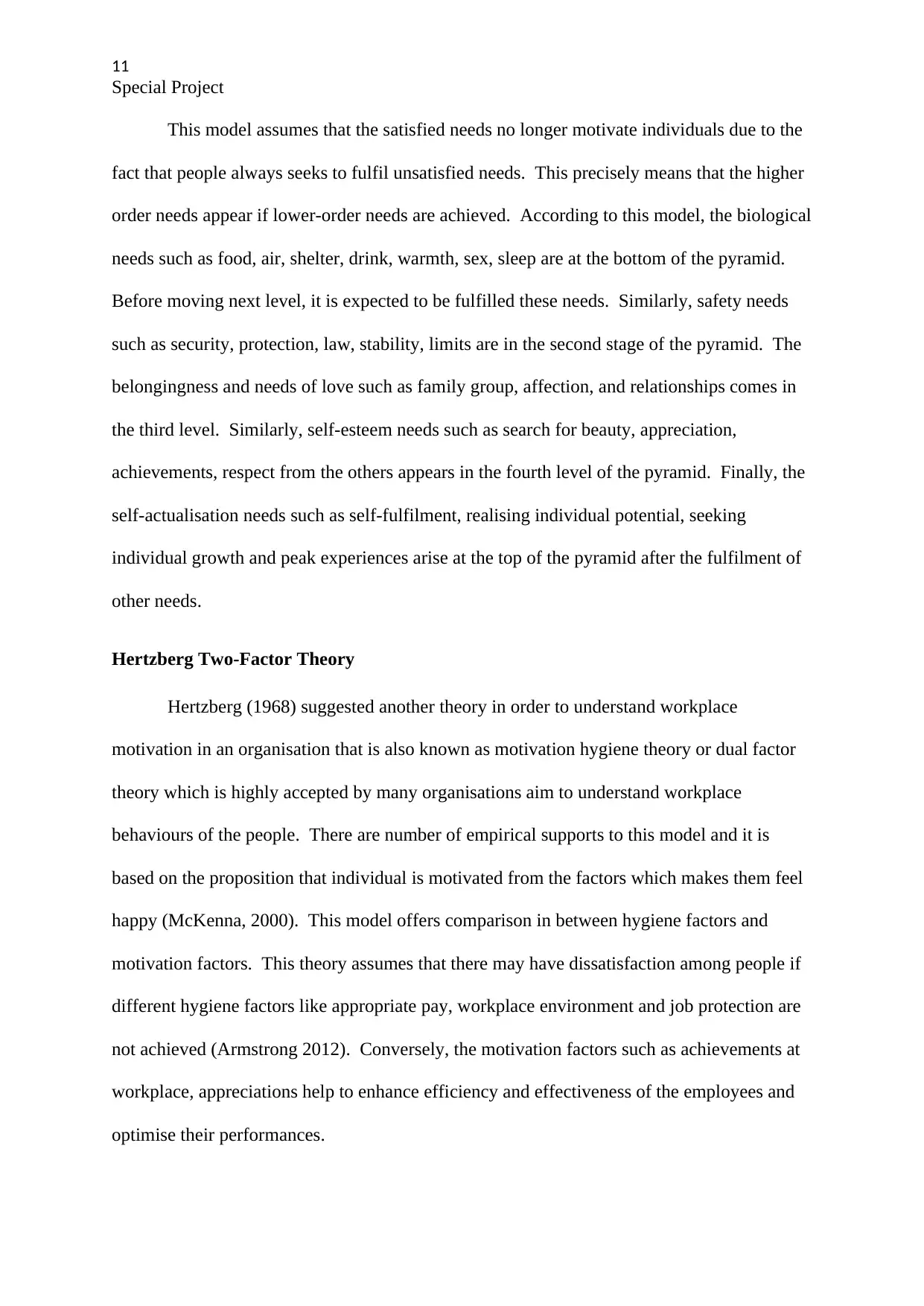
11
Special Project
This model assumes that the satisfied needs no longer motivate individuals due to the
fact that people always seeks to fulfil unsatisfied needs. This precisely means that the higher
order needs appear if lower-order needs are achieved. According to this model, the biological
needs such as food, air, shelter, drink, warmth, sex, sleep are at the bottom of the pyramid.
Before moving next level, it is expected to be fulfilled these needs. Similarly, safety needs
such as security, protection, law, stability, limits are in the second stage of the pyramid. The
belongingness and needs of love such as family group, affection, and relationships comes in
the third level. Similarly, self-esteem needs such as search for beauty, appreciation,
achievements, respect from the others appears in the fourth level of the pyramid. Finally, the
self-actualisation needs such as self-fulfilment, realising individual potential, seeking
individual growth and peak experiences arise at the top of the pyramid after the fulfilment of
other needs.
Hertzberg Two-Factor Theory
Hertzberg (1968) suggested another theory in order to understand workplace
motivation in an organisation that is also known as motivation hygiene theory or dual factor
theory which is highly accepted by many organisations aim to understand workplace
behaviours of the people. There are number of empirical supports to this model and it is
based on the proposition that individual is motivated from the factors which makes them feel
happy (McKenna, 2000). This model offers comparison in between hygiene factors and
motivation factors. This theory assumes that there may have dissatisfaction among people if
different hygiene factors like appropriate pay, workplace environment and job protection are
not achieved (Armstrong 2012). Conversely, the motivation factors such as achievements at
workplace, appreciations help to enhance efficiency and effectiveness of the employees and
optimise their performances.
Special Project
This model assumes that the satisfied needs no longer motivate individuals due to the
fact that people always seeks to fulfil unsatisfied needs. This precisely means that the higher
order needs appear if lower-order needs are achieved. According to this model, the biological
needs such as food, air, shelter, drink, warmth, sex, sleep are at the bottom of the pyramid.
Before moving next level, it is expected to be fulfilled these needs. Similarly, safety needs
such as security, protection, law, stability, limits are in the second stage of the pyramid. The
belongingness and needs of love such as family group, affection, and relationships comes in
the third level. Similarly, self-esteem needs such as search for beauty, appreciation,
achievements, respect from the others appears in the fourth level of the pyramid. Finally, the
self-actualisation needs such as self-fulfilment, realising individual potential, seeking
individual growth and peak experiences arise at the top of the pyramid after the fulfilment of
other needs.
Hertzberg Two-Factor Theory
Hertzberg (1968) suggested another theory in order to understand workplace
motivation in an organisation that is also known as motivation hygiene theory or dual factor
theory which is highly accepted by many organisations aim to understand workplace
behaviours of the people. There are number of empirical supports to this model and it is
based on the proposition that individual is motivated from the factors which makes them feel
happy (McKenna, 2000). This model offers comparison in between hygiene factors and
motivation factors. This theory assumes that there may have dissatisfaction among people if
different hygiene factors like appropriate pay, workplace environment and job protection are
not achieved (Armstrong 2012). Conversely, the motivation factors such as achievements at
workplace, appreciations help to enhance efficiency and effectiveness of the employees and
optimise their performances.
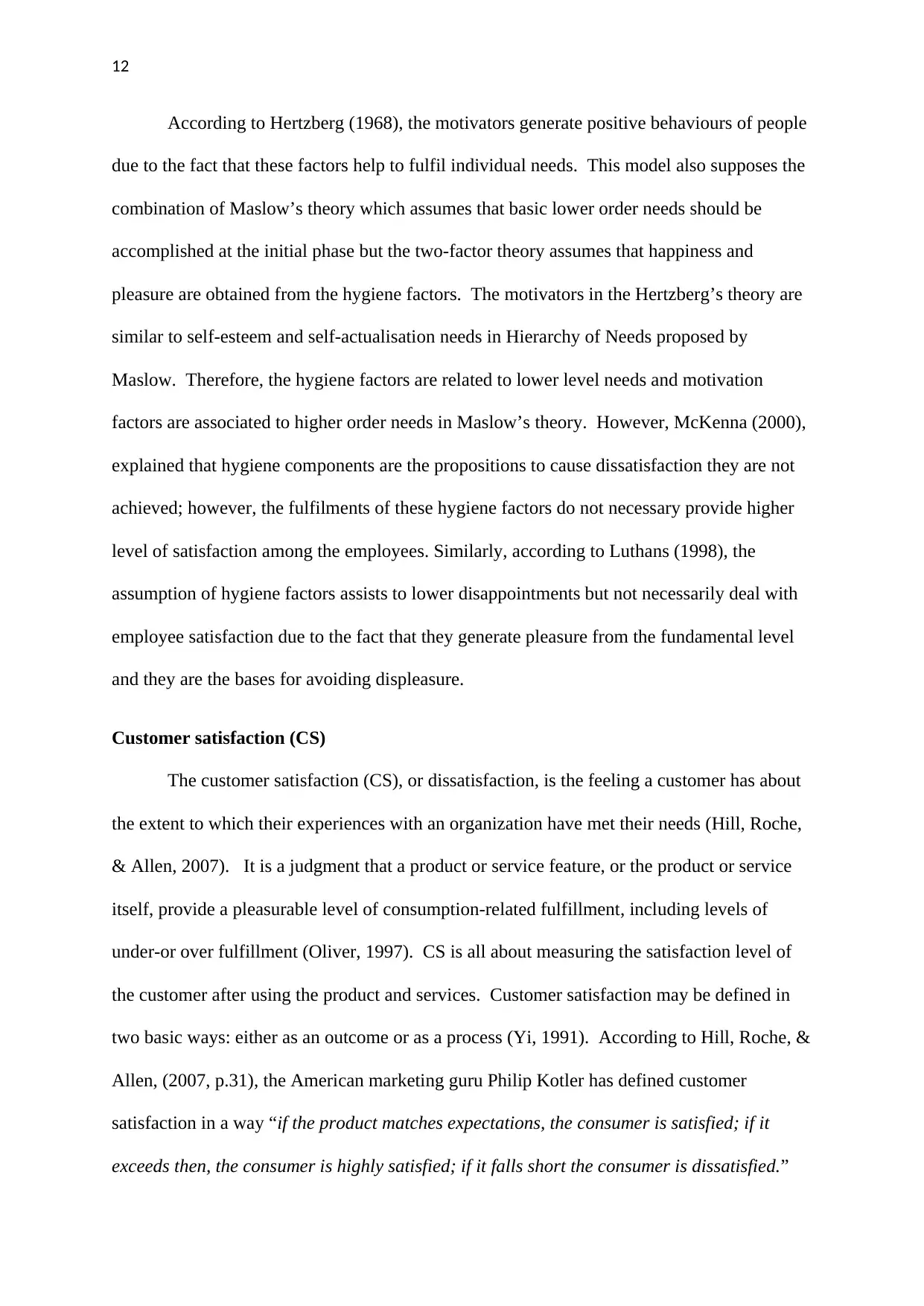
12
According to Hertzberg (1968), the motivators generate positive behaviours of people
due to the fact that these factors help to fulfil individual needs. This model also supposes the
combination of Maslow’s theory which assumes that basic lower order needs should be
accomplished at the initial phase but the two-factor theory assumes that happiness and
pleasure are obtained from the hygiene factors. The motivators in the Hertzberg’s theory are
similar to self-esteem and self-actualisation needs in Hierarchy of Needs proposed by
Maslow. Therefore, the hygiene factors are related to lower level needs and motivation
factors are associated to higher order needs in Maslow’s theory. However, McKenna (2000),
explained that hygiene components are the propositions to cause dissatisfaction they are not
achieved; however, the fulfilments of these hygiene factors do not necessary provide higher
level of satisfaction among the employees. Similarly, according to Luthans (1998), the
assumption of hygiene factors assists to lower disappointments but not necessarily deal with
employee satisfaction due to the fact that they generate pleasure from the fundamental level
and they are the bases for avoiding displeasure.
Customer satisfaction (CS)
The customer satisfaction (CS), or dissatisfaction, is the feeling a customer has about
the extent to which their experiences with an organization have met their needs (Hill, Roche,
& Allen, 2007). It is a judgment that a product or service feature, or the product or service
itself, provide a pleasurable level of consumption-related fulfillment, including levels of
under-or over fulfillment (Oliver, 1997). CS is all about measuring the satisfaction level of
the customer after using the product and services. Customer satisfaction may be defined in
two basic ways: either as an outcome or as a process (Yi, 1991). According to Hill, Roche, &
Allen, (2007, p.31), the American marketing guru Philip Kotler has defined customer
satisfaction in a way “if the product matches expectations, the consumer is satisfied; if it
exceeds then, the consumer is highly satisfied; if it falls short the consumer is dissatisfied.”
According to Hertzberg (1968), the motivators generate positive behaviours of people
due to the fact that these factors help to fulfil individual needs. This model also supposes the
combination of Maslow’s theory which assumes that basic lower order needs should be
accomplished at the initial phase but the two-factor theory assumes that happiness and
pleasure are obtained from the hygiene factors. The motivators in the Hertzberg’s theory are
similar to self-esteem and self-actualisation needs in Hierarchy of Needs proposed by
Maslow. Therefore, the hygiene factors are related to lower level needs and motivation
factors are associated to higher order needs in Maslow’s theory. However, McKenna (2000),
explained that hygiene components are the propositions to cause dissatisfaction they are not
achieved; however, the fulfilments of these hygiene factors do not necessary provide higher
level of satisfaction among the employees. Similarly, according to Luthans (1998), the
assumption of hygiene factors assists to lower disappointments but not necessarily deal with
employee satisfaction due to the fact that they generate pleasure from the fundamental level
and they are the bases for avoiding displeasure.
Customer satisfaction (CS)
The customer satisfaction (CS), or dissatisfaction, is the feeling a customer has about
the extent to which their experiences with an organization have met their needs (Hill, Roche,
& Allen, 2007). It is a judgment that a product or service feature, or the product or service
itself, provide a pleasurable level of consumption-related fulfillment, including levels of
under-or over fulfillment (Oliver, 1997). CS is all about measuring the satisfaction level of
the customer after using the product and services. Customer satisfaction may be defined in
two basic ways: either as an outcome or as a process (Yi, 1991). According to Hill, Roche, &
Allen, (2007, p.31), the American marketing guru Philip Kotler has defined customer
satisfaction in a way “if the product matches expectations, the consumer is satisfied; if it
exceeds then, the consumer is highly satisfied; if it falls short the consumer is dissatisfied.”
⊘ This is a preview!⊘
Do you want full access?
Subscribe today to unlock all pages.

Trusted by 1+ million students worldwide
1 out of 36
Related Documents
Your All-in-One AI-Powered Toolkit for Academic Success.
+13062052269
info@desklib.com
Available 24*7 on WhatsApp / Email
![[object Object]](/_next/static/media/star-bottom.7253800d.svg)
Unlock your academic potential
Copyright © 2020–2025 A2Z Services. All Rights Reserved. Developed and managed by ZUCOL.





